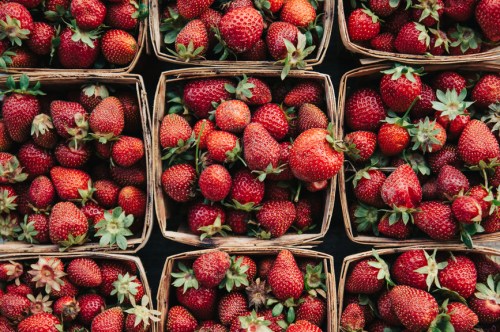‘I’m a Food Scientist—This 2-Second Trick Will Keep Your Fresh Berries From Turning to Mold Overnight’
An expert in food safety shares how to keep berries fresh and why turning the container over before you buy is the best method.

As each summer rolls around, there’s no shortage of things to look forward to—with warmer days, summer Fridays, and peak berry season among them. Whether you purchase your blueberries, raspberries, blackberries, or strawberries at your local farmers market or grocery store, there’s one hack you’ll want to follow before each and every purchase to ensure you get the freshest berries for your buck.
Experts in This Article
virologist and senior director of food technology communications at International Food Information Council
Keep reading to see what the foolproof trick is. Plus: everything a food safety expert suggests to store, prep, and ultimately enjoy your berries to the fullest.
Why you should always turn the container over before you buy to keep berries fresh
While this berry-buying hack is oh-so-simple, it’s crucial to put into practice. A quick glance at the bottom of your berry container can help you detect mold and moisture, thus saving you the heartbreak of discovering a slimy container of produce you’ll need to toss in a day or two’s time.
According to Tamika Sims, PhD, food scientist and senior director of food technology communications at the International Food Information Council (IFIC), mold can grow on fruit that has broken skin and exposed flesh. Because berries have a smaller surface area than, say, an apple, any mold “likely impacts the entire berry and should be discarded,” she explains. “The mold can also migrate from one berry to another if they are touching in a small container, like those you find in markets.”
Ideally, you’ll detect the growth before your purchase and opt for another container entirely. But if it’s too late and you’re wondering if it’s okay to go ahead and eat berries that appear to be mold-free, Dr. Sims shares a few important FYIs.
Of course, you’ll need to toss the moldy berries. From there, inspect the berries that touched those for signs of spoilage. “If you see mold, feel mushy skin, or see discoloration, then these berries must also be discarded,” Dr. Sims advises. “If there are no clear signs of the mold traveling to the nearby berries, you can wash them thoroughly and set them aside for consumption.”
However, if you’re on the fence if certain berries are salvageable, Dr. Sims suggests erring on the side of caution. (Minimizing food waste is a worthy goal, but you shouldn’t do so at your health’s expense.) “According to USDA, mold can cause allergic reactions, respiratory issues, and sometimes even more severe reactions,” she shares. But if you only realize mid-chew that a spoiled berry is, in fact, in your mouth, you shouldn’t stress about it too much. “If you’ve already consumed the molded berry by accident, you might not feel any differently,” Dr. Sims says. “One moldy blueberry might not make you sick, but several can lead to foodborne illness symptoms.”
3 more tips to keep your berries fresh and mold-free
Now that you know how important it is to flip over your berry container before your purchase—as well as what to do if you detect mold—follow these additional tips and tricks to keep your berries fresher for longer.
1. Keep berries in an airy container
Most berry containers are open or have cutouts that allow for air circulation, which Dr. Sims says is ideal. If you have fancy food storage sets on hand, it’s best to save them for another use. “If you need to discard the [original berry] container, be sure to put the berries in one that allows for air circulation—not an airtight container,” she advises.
2. Refrigerate them at the right temperature
“Berries are perishable, so they need to be stored in a refrigerator at a temperature of 40°F or below, according to the FDA,” Dr. Sims continues. “Use a refrigerator thermometer to monitor your refrigerator temperature to ensure this.” Moreover, your fridge may have a specific bin or drawer to store produce, which can help promote their freshness and longevity.
3. Wash berries only before eating them
Dr. Sims says that you should always wash berries directly before you’re ready to consume them, rather than in advance. “You can certainly inspect the container for spoilage or mold, and use the advice above if mold occurs. But otherwise, don’t wash them all and then put them back in the refrigerator,” she shares. The key is learning how to wash strawberries like a pro (hint: a little water and baking soda).
By following the tips above, you can stave off premature mold and better ensure that you enjoy your berries until the very last bite. On a parting note, Dr. Sims suggests consulting the FoodKeeper App to help you maximize the quality of specific foods—including but certainly not limited to specific berries and other types of produce—whether fresh or frozen.
Sign Up for Our Daily Newsletter
Get all the latest in wellness, trends, food, fitness, beauty, and more delivered right to your inbox.
Got it, you've been added to our email list.










